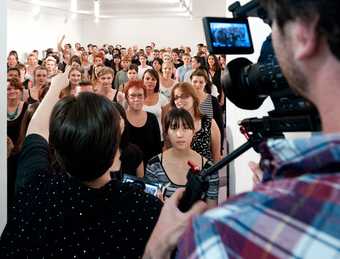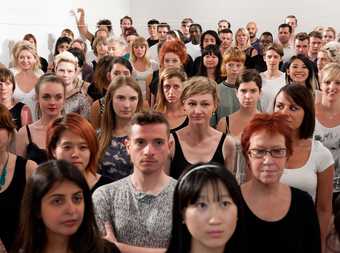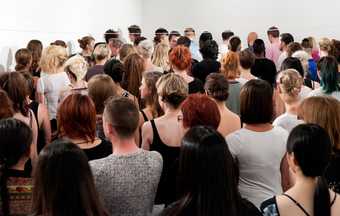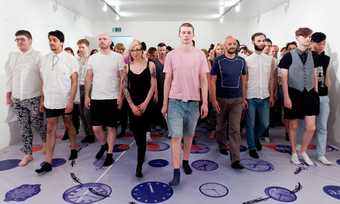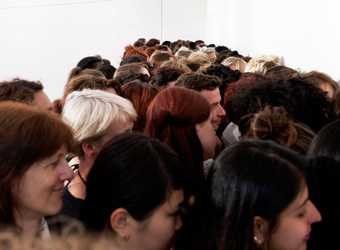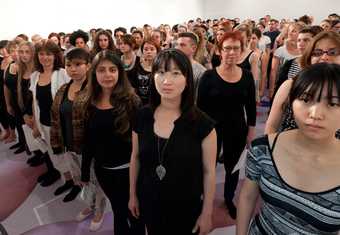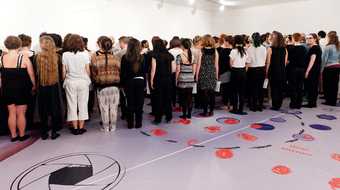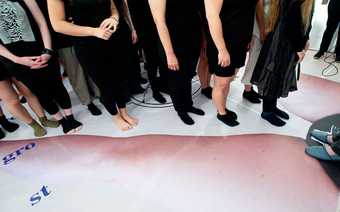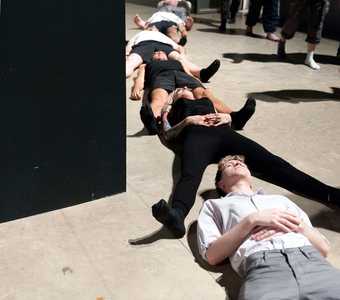American artist Emily Roysdon’s piece for BMW Tate Live: Performance Room took place on 31 May 2012. Involving 105 volunteers and following a week of group meetings and rehearsals, the ten-minute performance I am a helicopter, camera, queen responded to the physical space of the McAulay Gallery at Tate Modern and the conceptual space of the Performance Room’s online format. The Performance Room series offered invitations to artists to create a one-time performance to be live-streamed through Tate’s YouTube channel. There was not a live audience in the room during the performance, but online viewers could see the performance as it happened, interact with one another through social media channels, and raise questions during a subsequent online question and answer session. The live-stream of the work and the discussion was digitally archived on Tate’s YouTube channel and website and, as such, was available anywhere, at any time after the initial performance.
The opening shot of I am a helicopter, camera, queen created the impression of a fully occupied space. The 105 performers – selected through an open call for volunteers who self-identified as queer or feminist – stood in rows facing the camera, filling all the available space; or as Roysdon phrased it ‘building the space’.1 The camera itself was not permitted to enter the room and instead remained at the perimeter, looking in at the participants. From this vantage point the camera captured the movements of the performers, which were guided by a score of shapes, images and words marked out on the floor. Moving as one group, they created formations, including triangular shapes oriented diagonally across the room, or lines facing the left wall, then the right. The distance between the performers narrowed and expanded, meaning the group alternately occupied more or less of the room. At one point the group turned in formation while remaining together as close as possible, fitting the same number of people into half the space they had previously occupied. Their bodies, both individually and as a unit, became tools for measuring the dimensions of the room, playing with scale and perspective to explore the space for the online viewers, who could see only a flattened image.
Occasionally single performers broke away from the group to utter a phrase or to perform a particular solo movement, such as sitting on another performer’s shoulders to explore the height of the room, or holding up a folded newspaper with the title of the performance handwritten in capital letters across the printed page. Other utterances found collective expression, such as when the group proclaimed – in unison or in call-and-response – words related to the printed score shown on the floor, such as ‘clock’ and ‘confession’. In doing so the group explored the personal ownership and use of language, and the power of collective speech. Read in conjunction with the exploration of physical spaces of queerness and queer identity, these vocal aspects of the performance drew on the potential for using language as a way to create and shape queer spaces.
The artist’s website annouced:
Roysdon thinks of the helicopter, camera, and queen as representations of territory and seeing – regimes of viewing and ways of understanding space….Taking the precise confines of the room itself as the score, and thinking about scale, resources and units of measure, the choreography will ‘make room,’ reconstituting and queering a previously defined space. The participants will attempt to be exactly in the space, to be audience and performer, to be in time and to create a stage within their collectivity. The room will be full and the participants will be guided by a room size score below their feet, that once the live action is complete will remain as a document of the event.2
Eventually the camera moved from the threshold into the room itself; at the same moment the door at the back of the room opened and the performers began to move out. A final group remained in a line, standing on an image of a pair of legs and thighs which formed a ‘V’ on the floor of the room. Each performer shouted out a single word before falling to the floor. The camera then moved freely throughout the room, tracing the prone bodies out of the door and into the expansive space of the Turbine Hall. The performers who had left the room now lay on the floor of the Turbine Hall, each forming part of a ‘birth chain’ with their head between the ‘V’-shape of another performer’s legs. The camera followed the length of the chain, while the performers shouted improvised words or phrases that echoed around the Turbine Hall.3
The bodies that had formerly been confined within the small gallery space stretched into the darkness of the adjoining Turbine Hall. The contrast between the restricted but intimate movements enacted within the McAulay Gallery and the larger, sprawling movements in the Turbine Hall offered two different formulations of the group’s performance of socio-political identity.
Acatia Finbow
October 2015

